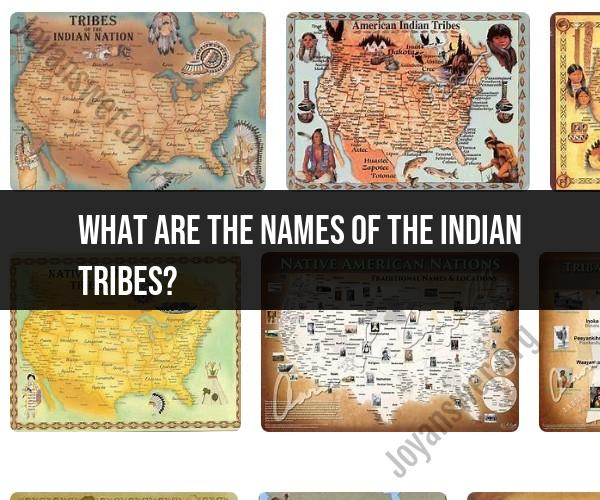What are the names of the Indian tribes?
India is a diverse country with a rich cultural heritage and a multitude of indigenous communities and tribes. It's important to note that there are many distinct tribes across India, each with its own unique culture, language, and way of life. Here are some of the major tribes in India, along with their names and a brief description of their cultures:
Gond Tribe: The Gond people are one of the largest tribal groups in India. They primarily inhabit the central and eastern regions of India. Gonds are known for their colorful art, music, and traditional rituals.
Santhal Tribe: The Santhal tribe is mainly found in the states of Jharkhand, West Bengal, and Odisha. They have a rich tradition of music and dance and are known for their Santali language.
Bhils Tribe: The Bhil tribe is found in the western and central parts of India, particularly in Rajasthan, Gujarat, and Madhya Pradesh. They are known for their vibrant dance forms and traditional attire.
Oraon Tribe: The Oraon, also known as Kurukh, are a tribal group in the states of Jharkhand, Chhattisgarh, and Odisha. They have a distinct culture and language.
Khasi Tribe: The Khasi people primarily inhabit the northeastern state of Meghalaya. They have a matrilineal society and are known for their traditional jaintia and Khasi cultures.
Munda Tribe: The Munda tribe is mainly concentrated in Jharkhand, West Bengal, and Odisha. They have their language, Munda, and are known for their vibrant festivals and rituals.
Naga Tribes: Nagaland is home to various Naga tribes, each with its language and customs. The Naga people are known for their rich cultural heritage and distinctive shawls.
Adivasi Communities: Adivasi is a collective term for various indigenous communities in India. These communities are spread across the country and include numerous distinct tribes with their languages and traditions.
Jarwa Tribe: The Jarwa tribe is one of the indigenous tribes of the Andaman and Nicobar Islands. They live in relative isolation and have their language.
Sentinelese Tribe: The Sentinelese are an extremely isolated indigenous tribe residing on North Sentinel Island in the Andaman and Nicobar archipelago. They have minimal contact with the outside world.
These are just a few examples of the many indigenous tribes in India. The country is incredibly diverse, and each tribe has its own unique culture, language, traditions, and way of life. It's important to recognize and respect the cultural diversity and heritage of these tribes.
Unveiling the Diversity of Indian Tribes
There are over 570 federally recognized Indian tribes in the United States, each with its own unique culture, language, and history. The diversity of Indian tribes is a testament to the resilience and adaptability of their people.
Indian tribes have a rich history dating back thousands of years. They have lived in all parts of the United States, from the Arctic to the Gulf Coast. Indian tribes have made significant contributions to American culture and society, including agriculture, art, music, and dance.
The Names of Prominent Indian Tribes Across the Nation
Here are a few examples of prominent Indian tribes across the nation:
- Cherokee
- Navajo
- Apache
- Sioux
- Comanche
- Cheyenne
- Blackfeet
- Iroquois
- Seminole
- Choctaw
- Chickasaw
- Lumbee
These tribes are just a few examples of the many diverse Indian tribes that make up the fabric of American society.
Exploring the Rich Cultural Heritage of Indian Tribes
Indian tribes have a rich cultural heritage that is passed down from generation to generation. This heritage includes traditional languages, religions, arts, and crafts.
Indian tribes have a strong sense of community and tradition. They often have elaborate ceremonies and festivals to celebrate their culture and heritage. Indian tribes also have a strong connection to the land and their ancestors.
Historical and Geographical Contexts of Indian Tribe Names
Indian tribe names often have historical and geographical significance. For example, the Cherokee tribe is named after the Cherokee River, which flows through their traditional homeland in Georgia and North Carolina.
Some Indian tribe names are based on their language or culture. For example, the Navajo tribe is named after the Navajo word for "people."
Other Indian tribe names are based on their physical characteristics or appearance. For example, the Comanche tribe is named after the Comanche word for "snake people."
Preserving and Celebrating Indian Tribal Traditions
Indian tribes are working to preserve and celebrate their traditions in a variety of ways. They are teaching their languages to their children, hosting cultural events, and revitalizing their traditional arts and crafts.
Indian tribes are also working to protect their sacred sites and cultural resources. They are also advocating for their rights and interests at the federal, state, and local levels.
We can all play a role in preserving and celebrating Indian tribal traditions by learning more about Indian tribes, attending their cultural events, and supporting their businesses. We can also advocate for their rights and interests.
It is important to remember that Indian tribes are not just a part of history. They are vibrant and living cultures that are an important part of the fabric of American society.


